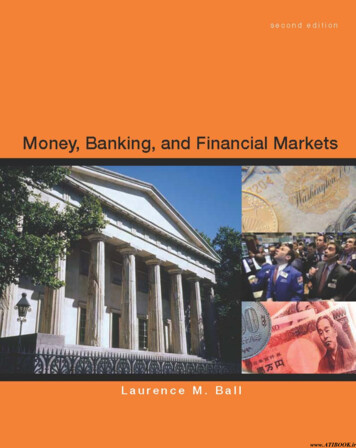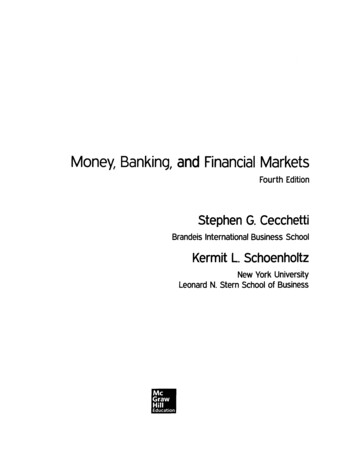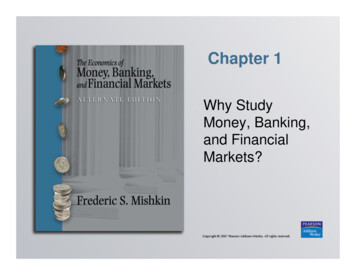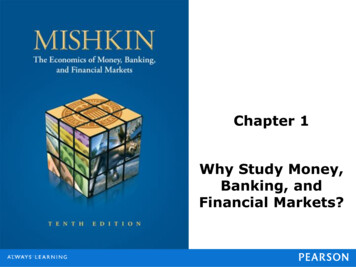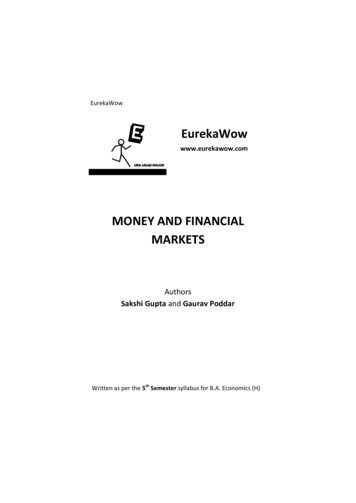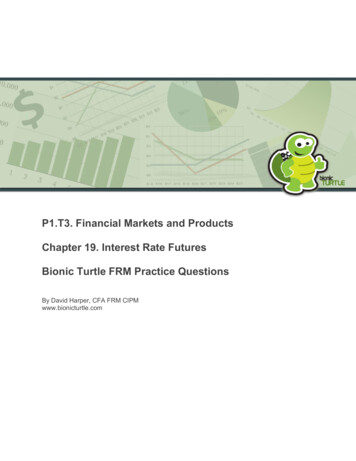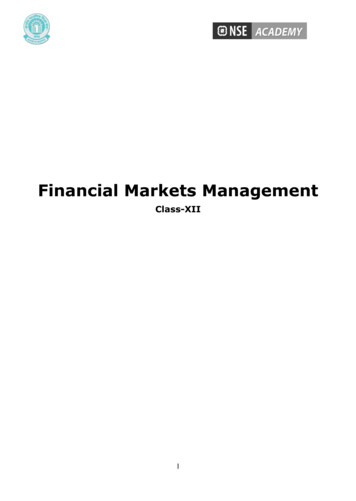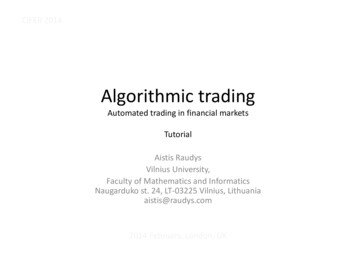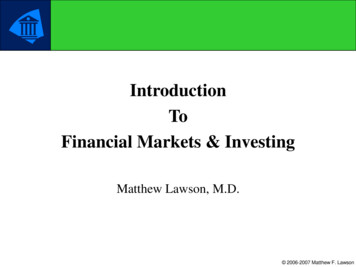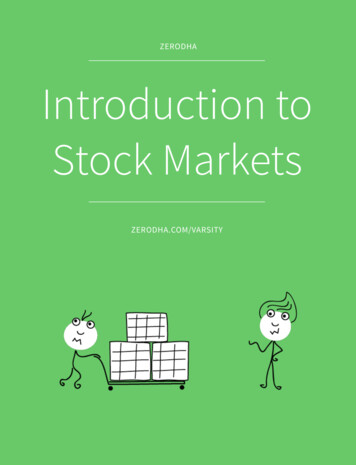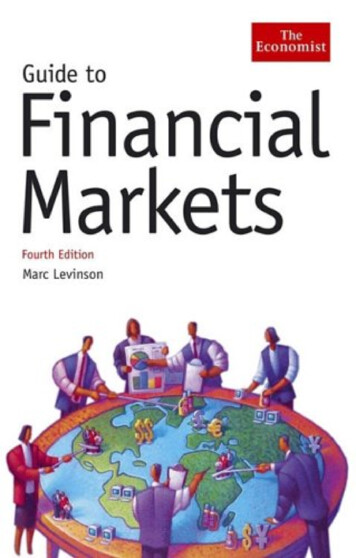
Transcription
GUIDE TO FINANCIAL MARKETS
OTHER ECONOMIST TITLESGuide to Analysing CompaniesGuide to Business ModellingGuide to Business PlanningGuide to Economic IndicatorsGuide to the European UnionGuide to Management IdeasNumbers GuideStyle GuideDictionary of BusinessDictionary of EconomicsInternational Dictionary of FinanceBrands and BrandingBusiness ConsultingBusiness EthicsBusiness MiscellanyBusiness StrategyChina’s StockmarketDealing with Financial RiskFuture of TechnologyGlobalisationHeadhunters and How to Use ThemSuccessful MergersThe CityWall StreetEssential DirectorEssential EconomicsEssential FinanceEssential InternetEssential InvestmentEssential NegotiationPocket World in Figures
GUIDE TO FINANCIAL MARKETSMarc Levinson
THE ECONOMIST IN ASSOCIATION WITHPROFILE BOOKS LTDThis fourth edition published in 2005 by Profile Books Ltd3a Exmouth House, Pine Street, London ec1r 0jhwww.profilebooks.comCopyright The Economist Newspaper Ltd, 1999, 2000, 2002, 2006Text copyright Marc Levinson, 1999, 2000, 2002, 2006All rights reserved. Without limiting the rights under copyright reserved above, nopart of this publication may be reproduced, stored in or introduced into a retrievalsystem, or transmitted, in any form or by any means (electronic, mechanical,photocopying, recording or otherwise), without the prior written permission of boththe copyright owner and the publisher of this book.The greatest care has been taken in compiling this book.However, no responsibility can be accepted by the publishers or compilersfor the accuracy of the information presented.Where opinion is expressed it is that of the author and does not necessarily coincidewith the editorial views of The Economist Newspaper.Typeset in EcoType by MacGuruinfo@macguru.org.ukPrinted in Great Britain byCreative Print and Design (Wales), Ebbw ValeA CIP catalogue record for this book is availablefrom the British LibraryISBN 1 86197 956 8978 1 86197 956 8
Contents123456789Why markets matterForeign-exchange marketsMoney marketsBond marketsSecuritisationInternational fixed-income marketsEquity marketsCommodities and futures marketsOptions and derivatives markets114375894115129167199Index231
1Why markets matterThe euro is slightly higher against the yen. The Dow Jones IndustrialAverage is off 18 points in active trading. A Chinese airline loses millions of dollars with derivatives. Following the Bank of England’s decision to lower its base rate, monthly mortgage payments are set to fall.All these events are examples of financial markets at work. That markets exercise enormous influence over modern life comes as no news.But although people around the world speak glibly of “Wall Street”, “thebond market” and “the currency markets”, the meanings they attach tothese time-worn phrases are often vague and usually out of date. Thisbook explains the purposes different financial markets serve and clarifies the way they work. It cannot tell you whether your investment portfolio is likely to rise or to fall in value. But it may help you understandhow its value is determined, and how the different securities in it arecreated and traded.In the beginningThe word “market” usually conjures up an image of the bustling, paperstrewn floor of the New York Stock Exchange or of traders motioningfrantically in the futures pits of Chicago. But formal exchanges such asthese are only one aspect of the financial markets, and far from the mostimportant one. There were financial markets long before there wereexchanges and, in fact, long before there was organised trading of anysort.Financial markets have been around ever since mankind settleddown to growing crops and trading them with others. After a bad harvest, those early farmers would have needed to obtain seed for the nextseason’s planting, and perhaps to get food to see their families through.Both of these transactions would have required them to obtain creditfrom others with seed or food to spare. After a good harvest, the farmers would have had to decide whether to trade away their surplusimmediately or to store it, a choice that any 20th-century commoditiestrader would find familiar. The amount of fish those early farmers couldobtain for a basket of cassava would have varied day by day, depending upon the catch, the harvest and the weather; in short, their exchangerates were volatile.The independent decisions of all of those farmers constituted a basic1
GUIDE TO FINANCIAL MARKETSfinancial market, and that market fulfilled many of the same purposesas financial markets do today.What do markets do?Financial markets take many different forms and operate in diverseways. But all of them, whether highly organised, like the London StockExchange, or highly informal, like the money changers on the street corners of many African capitals, serve the same basic functions. Price setting. The value of an ounce of gold or a share of stock is 2no more, and no less, than what someone is willing to pay toown it. Markets provide price discovery, a way to determine therelative values of different items, based upon the prices at whichindividuals are willing to buy and sell them.Asset valuation. Market prices offer the best way to determinethe value of a firm or of the firm’s assets, or property. This isimportant not only to those buying and selling businesses, butalso to regulators. An insurer, for example, may appear strong if itvalues the securities it owns at the prices it paid for them yearsago, but the relevant question for judging its solvency is whatprices those securities could be sold for if it needed cash to payclaims today.Arbitrage. In countries with poorly developed financial markets,commodities and currencies may trade at very different prices indifferent locations. As traders in financial markets attempt toprofit from these divergences, prices move towards a uniformlevel, making the entire economy more efficient.Raising capital. Firms often require funds to build new facilities,replace machinery or expand their business in other ways.Shares, bonds and other types of financial instruments make thispossible. Increasingly, the financial markets are also the source ofcapital for individuals who wish to buy homes or cars, or even tomake credit-card purchases.Commercial transactions. As well as long-term capital, thefinancial markets provide the grease that makes manycommercial transactions possible. This includes such things asarranging payment for the sale of a product abroad, andproviding working capital so that a firm can pay employees ifpayments from customers run late.Investing. The stock, bond and money markets provide an
WHY MARKETS MATTERTable 1.1 Amounts raised in financial markets ( bn, net of repayments)1996International bank loans405International bonds and notes499International money-market instruments41Domestic bonds and notes1,497Domestic money-market instruments401International equity issues83Domestic equity issues438Total excluding domestic ,75420041,3431,560612,4617742145937,006Sources: Bank for International Settlements; World Federation of Exchangesopportunity to earn a return on funds that are not neededimmediately, and to accumulate assets that will provide anincome in future. Risk management. Futures, options and other derivativescontracts can provide protection against many types of risk, suchas the possibility that a foreign currency will lose value againstthe domestic currency before an export payment is received.They also enable the markets to attach a price to risk, allowingfirms and individuals to trade risks until they hold only those thatthey wish to retain.The size of the marketsEstimating the overall size of the financial markets is difficult. It is hardin the first place to decide exactly what transactions should be includedunder the rubric “financial markets”, and there is no way to compilecomplete data on each of the millions of sales and purchases occurringeach year. Total capital market financing was approximately 7 trillionworldwide in 2004, excluding purely domestic loans that were notresold in the form of securities (see Table 1.1).The figure of 7 trillion for 2004, sizeable as it is, represents only asingle year’s activity. Another way to look at the markets is to estimatethe value of all the financial instruments they trade. When measured inthis way, the financial markets accounted for 109 trillion of capital in2004 (see Table 1.2 on the next page). Large as it is, this figure excludesmany important financial activities, such as insurance underwriting,3
GUIDE TO FINANCIAL MARKETSTable 1.2 The world’s financial markets ( trn)International bonds and notesInternational money-market instrumentsDomestic bonds and notesDomestic money-market instrumentsInternational bank loansDomestic equitiesTotal value 109.1Source: Bank for International Settlementsbank lending to individuals and small businesses, and trading in financial instruments such as futures and derivatives that are not means ofraising capital. If all of these other financial activities were to beincluded, the total size of the markets would be much larger.Cross-border measureAnother way of measuring the growth of finance is to examine thevalue of cross-border financing. Cross-border finance is by no meansnew, and at various times in the past (in the late 19th century, for example) it has been quite large relative to the size of the world economy. Theperiod since 1990 has been marked by a huge increase in the amount ofinternational financing broken by financial crises in Asia and Russia in1998 and the recession in the United States in 2001. The total stock ofcross-border finance in 2005, including international bank loans anddebt issues, was more than 30 trillion, according to the Bank for International Settlements.Looking strictly at securities provides an even more dramatic pictureof the growth of the financial markets. A quarter of a century ago, crossborder purchases and sales of securities amounted to only a tiny fraction of most countries’ economic output. Today, annual cross-bordershare and bond transactions are several times larger than gdp in anumber of advanced economies – Japan being a notable exception.International breakdownThe ways in which firms and governments raise funds in internationalmarkets have changed substantially. In 1993, bonds accounted for 59%4
WHY MARKETS MATTERTable 1.3 Financing on international capital markets, by type of instrument ( bn)1996Bonds and money-market instruments 543Equities83Syndicated 42Source: Bank for International Settlementsof international financing. By 1997, before the financial crises in Asiaand Russia shook the markets, only 47% of the funds raised on international markets were obtained through bond issues. Equities becamean important source of cross-border financing in 2000, when shareprices were extremely high, but bonds and loans regained importancein the low-interest-rate environment of 2002–05. Table 1.3 lists theamounts of capital raised by the main instruments used in international markets.Turn-of-the-century slowdownBy all of these measures, financial markets grew extremely rapidlyduring the 1990s. At the start of the decade, active trading in financialinstruments was confined to a small number of countries, and involvedmainly the same types of securities, bonds and equities that had dominated trading for two centuries. By the first years of the 21st century,however, financial markets were thriving in dozens of countries, andnew instruments accounted for a large proportion of market dealings.The expansion of financial-market activity paused in 1998 inresponse to banking and exchange-rate crises in a number of countries.The crises passed quickly, however, and in 1999 financial-market activity reached record levels following the inauguration of the single European currency, interest-rate declines in Canada, the UK and continentalEurope, and a generally positive economic picture, marred by only smallrises in interest rates, in the United States. Equity-market activity slowedsharply in 2000 and 2001, as share prices fell in many countries, butbond-market activity was robust. Trading in foreign-exchange marketsfell markedly at the turn of the century. Bond markets remained veryactive through 2005.5
GUIDE TO FINANCIAL MARKETSThe general increase in financial-market activity can be traced to fourmain factors: Lower inflation. Inflation rates around the world have fallensharply since the 1980s. Inflation erodes the value of financialassets and increases the value of physical assets, such as housesand machines, which will cost far more to replace than they areworth today. When inflation is high, as was the case in theUnited States, Canada and much of Europe during the 1970s andthroughout Latin America in the 1980s, firms avoid raising longterm capital because investors require a high return oninvestment, knowing that price increases will render much of thatreturn illusory. In a low-inflation environment, however,financial-market investors require less of an inflation premium, asgeneral increases in prices will not devalue their assets and theprices of many physical assets are stable or even falling. Pensions. A significant change in pension policies is under wayin many countries. Since the 1930s, and even longer in somecountries, governments have operated pay-as-you-go schemes toprovide income to the elderly. These schemes, such as the old agepension in the UK and the social security programme in theUnited States, tax current workers to pay current pensioners andtherefore involve no saving or investment. Changes indemography and working patterns have made pay-as-you-goschemes increasingly costly to support, as there are fewer youngworkers relative to the number of pensioners. This has stimulatedinterest in pre-funded individual pensions, whereby each workerhas an account in which money must be saved, and thereforeinvested, until retirement. Although these personal investmentaccounts have to some extent supplanted firms’ private pensionplans, they have also led to a huge increase in financial assets incountries where private pension schemes were previouslyuncommon. Stock and bond market performance. Many countries’ stockand bond markets performed well during most of the 1990s. Therapid increase in financial wealth feeds on itself: investors whoseportfolios have appreciated are willing to reinvest some of theirprofits in the financial markets. And the appreciation in the valueof their financial assets gives investors the collateral to borrowadditional money, which can then be invested.6
WHY MARKETS MATTER Risk management. Innovation has generated many newfinancial products, such as derivatives and asset-backed securities,whose basic purpose is to redistribute risk. This has led toenormous growth in the use of financial markets for riskmanagement purposes. To an extent unimaginable a few yearsago, firms and investors are able to choose which risks they wishto bear and use financial instruments to shed the risks they do notwant, or, alternatively, to take on additional risks in theexpectation of earning higher returns. The risk that the euro willtrade above 1.40 during the next six months, or that the interestrate on long-term US Treasury bonds will rise to 6%, is nowpriced precisely in the markets, and financial instruments toprotect against these contingencies are readily available. Therisk-management revolution has thus resulted in an enormousexpansion of financial-market activity.The investorsThe driving force behind financial markets is the desire of investors toearn a return on their assets. This return has two distinct components: Yield is the income the investor receives while owning aninvestment. Capital gains are increases in the value of the investment itself,and are often not available to the owner until the investment issold.Investors’ preferences vary as to which type of return they prefer,and these preferences, in turn, will affect their investment decisions.Some financial-market products are deliberately designed to offer onlycapital gains and no yield, or vice versa, to satisfy these preferences.Investors can be divided broadly into two categories: Individuals. Collectively, individuals own a small proportion offinancial assets. Most households in the wealthier countries ownsome financial assets, often in the form of retirement savings orof shares in the employer of a household member. Most suchholdings, however, are quite small, and their composition variesgreatly from one country to another. In 2000, equities accountedfor nearly half of households’ financial assets in France, but onlyabout 8% in Japan. The great majority of individual investment is7
GUIDE TO FINANCIAL MARKETScontrolled by a comparatively small number of wealthyhouseholds. Nonetheless, individual investing has becomeincreasingly popular. In the United States, bank certificates ofdeposit accounted for more than 10% of households’ financialassets in 1989 but only 3.1% in 2001, as families shifted theirmoney into securities. Institutional investors. Insurance companies and otherinstitutional investors (see below) are responsible for most of thetrading in financial markets. The assets of institutional investorsbased in the 30 member countries of the oecd totalled about 35 trillion in 2001. They grew almost 12% per year between 1990and 1999, then declined in 2000 and 2001. The size of institutionalinvestors varies greatly from country to country, depending onthe development of collective investment vehicles. Investmentpractices vary considerably as well. In 2001, for example, USinstitutional investors kept 44% of their assets in the form ofshares and 35% in bonds, whereas British institutional investorsheld 65% of assets in shares. In Japan, 56% of institutionalinvestors’ assets were bonds, despite extremely low interest rates,and only 16% were shares.Mutual fundsThe fastest-growing institutional investors are investment companies,which combine the investments of a number of individuals with theaim of achieving particular financial goals in an efficient way. Mutualfunds and unit trusts are investment companies that typically accept anunlimited number of individual investments. The fund declares thestrategy it will pursue, and as additional money is invested the fundmanagers purchase financial instruments appropriate to that strategy.Investment trusts, some of which are known in the United States asclosed-end funds, issue a limited number of shares to investors at thetime they are established and use the proceeds to purchase financialinstruments in accordance with their strategy. In some cases, the trustacquires securities at its inception and never sells them; in other cases,the fund changes its portfolio from time to time. Investors wishing toenter or leave the unit trust must buy or sell the trust’s shares fromstockbrokers.Hedge fundsA third type of investment company, a hedge fund, can accept invest-8
WHY MARKETS MATTERTable 1.4 Financial assets of institutional investors (% of 0.9153.5232.74.4190.9191.0Source: OECDments from only a small number of wealthy individuals or big institutions. In return it is freed from most types of regulation meant to protectconsumers. Hedge funds are able to employ extremely aggressiveinvestment strategies, such as using borrowed money to increase theamount invested and focusing investment on one or another type ofasset rather than diversifying. If successful, such strategies can lead tovery large returns; if unsuccessful, they can result in sizeable losses andthe closure of the fund.All investment companies earn a profit by charging investors a feefor their services. Some, notably hedge funds, may also take a portion ofany gain in the value of the fund. Hedge funds have come under particular criticism because their fee structures may give managers an undesirable incentive to take large risks with investors’ money, as fundmanagers may share in their fund’s gains but not its losses.Insurance companiesInsurance companies are the most important type of institutionalinvestor, owning one-third of all the financial assets owned by institutions. In the past, most of these holdings were needed to back life insurance policies. In recent years, a growing share of insurers’ business has9
GUIDE TO FINANCIAL MARKETSconsisted of annuities, which guarantee policy holders a sum of moneyeach year as long as they live, rather than merely paying their heirsupon death. The growth of pre-funded individual pensions has benefited insurance companies, because on retirement many workers use themoney in their accounts to purchase annuities.Pension fundsPension funds aggregate the retirement savings of a large number ofworkers. Typically, pension funds are sponsored by an employer, agroup of employers or a labour union. Unlike individual pensionaccounts, pension funds do not give individuals control over how theirsavings are invested, but they do typically offer a guaranteed benefitonce the individual reaches retirement age. Pension-fund assets totalabout 10 trillion worldwide. Three countries, the United States, the UKand Japan, account for the overwhelming majority of this amount. Pension funds, although huge, are slowly diminishing in importance as individual pension accounts gain favour.Other types of institutions, such as banks, foundations and university endowment funds, are also substantial players in the markets.The rise of the formal marketsEvery country has financial markets of one sort or another. In countriesas diverse as China, Peru and Zimbabwe, investors can purchase sharesand bonds issued by local companies. Even in places whose governments loudly reject capitalist ideas, traders, often labelled disparaginglyas speculators, make markets in foreign currencies and in scarce commodities such as petrol. The formal financial markets have expandedrapidly in recent years, as governments in countries marked by shadowy, semi-legal markets have sought to organise institutions. The motivation was in part self-interest: informal markets generate no taxrevenue, but officially recognised markets do. Governments have alsorecognised that if businesses are to thrive they must be able to raise capital, and formal means of doing this, such as selling shares on a stockexchange, are much more efficient than informal means such as borrowing from moneylenders.Investors have many reasons to prefer formal financial markets tostreet-corner trading. Yet not all formal markets prosper, as investorsgravitate to certain markets and leave others underutilised. The busierones, generally, have important attributes that smaller markets oftenlack:10
WHY MARKETS MATTER Liquidity, the ease with trading can be conducted. In an illiquid market an investor may have difficulty finding another partyready to make the desired trade, and the difference, or “spread”,between the price at which a security can be bought and the pricefor which it can be sold, may be high. Trading is easier andspreads are narrower in more liquid markets. Because liquiditybenefits almost everyone, trading usually concentrates in marketsthat are already busy.Transparency, the availability of prompt and completeinformation about trades and prices. Generally, the lesstransparent the market, the less willing people are to trade there.Reliability, particularly when it comes to ensuring that trades arecompleted quickly according to the terms agreed.Legal procedures adequate to settle disputes and enforcecontracts.Suitable investor protection and regulation. Excessiveregulation can stifle a market. However, trading will also bedeterred if investors lack confidence in the available informationabout the securities they may wish to trade, the procedures fortrading, the ability of trading partners and intermediaries to meettheir commitments, and the treatment they will receive as ownersof a security or commodity once a trade has been completed.Low transaction costs. Many financial-market transactions arenot tied to a specific geographic location, and the participants willstrive to complete them in places where trading costs, regulatorycosts and taxes are reasonable.The forces of changeToday’s financial markets would be almost unrecognisable to someonewho traded there only two or three decades ago. The speed of changehas been accelerating as market participants struggle to adjust toincreased competition and constant innovation.TechnologyAlmost everything about the markets has been reshaped by the forcesof technology. Abundant computing power and cheap telecommunications have encouraged the growth of entirely new types of financialinstruments and have dramatically changed the cost structure of everypart of the financial industry.11
GUIDE TO FINANCIAL MARKETSDeregulationThe trend towards deregulation has been worldwide. It is not long sinceauthorities everywhere kept tight controls on financial markets in thename of protecting consumers and preserving financial stability. Butsince 1975, when the United States prohibited stockbrokers from settinguniform commissions for share trading, the restraints have been loosened in one country after another. Although there are great differences,most national regulators agree on the principles that individualinvestors need substantial protection, but that dealings involving institutional investors require little regulation.LiberalisationDeregulation has been accompanied by a general liberalisation of rulesgoverning participation in the markets. Many of the barriers that onceseparated banks, investment banks, insurers, investment companies andother financial institutions have been lowered, allowing such firms toenter each others’ businesses. The big market economies, most recentlyJapan and South Korea, have also allowed foreign firms to enter financial sectors that were formerly reserved for domestic companies.ConsolidationLiberalisation has led to consolidation, as firms merge to take advantageof economies of scale or to enter other areas of finance. Almost all of theUK’s leading investment banks and brokerage houses, for example,have been acquired by foreigners seeking a bigger presence in London,and many of the medium-sized investment banks in the United Stateswere bought by commercial banks wishing to use new powers toexpand in share dealing and corporate finance.GlobalisationConsolidation has gone hand in hand with globalisation. Most of theimportant financial firms are now highly international, with operationsin all the major financial centres. Many companies and governmentstake advantage of these global networks to issue shares and bonds outside their home countries. Investors increasingly take a global approachas well, putting their money wherever they expect the greatest returnfor the risk involved, without worrying about geography.This bookThe following chapters examine the most widely used financial instru-12
WHY MARKETS MATTERments and discuss the way the markets for each type of instrument areorganised. Chapter 2 establishes the background by explaining the currency markets, where exchange rates are determined. The money markets, where euro-commercial paper and domestic commercial paper areamong the instruments used for short-term financing, are discussed inChapter 3. The bond markets, the most important source of financing forcompanies and governments, are the subject of Chapter 4. Asset-backedsecurities, complicated but increasingly important instruments that havesome characteristics in common with bonds but also some importantdifferences, receive special attention in Chapter 5. Chapter 6 deals withoffshore markets, including the market for euro-notes. Chapter 7 discusses the area that may be most familiar to many readers, shares andequity markets. Chapter 8 covers exchange-traded futures, and Chapter9 discusses other sorts of derivatives. The markets for syndicated loansand other kinds of bank credit are beyond the scope of this book, as areinsurance products of all sorts.13
2IForeign-exchange marketsn every country prices are expressed in units of currency, eitherthat issued by the country’s central bank or a different one in whichindividuals prefer to denominate their transactions. The value of the currency itself, however, can be judged only against an external reference.This reference, the exchange rate, thus becomes the fundamental price inany economy. Most often, the references against which a currency’svalue is measured are other currencies. Determining the relative valuesof different currencies is the role of the foreign-exchange markets.The foreign-exchange markets underpin all other financial markets.They directly influence each country’s foreign-trade patterns, determinethe flow of international investment and affect domestic interest andinflation rates. They operate in every corner of the world, in every singlecurrency. Collectively, they form the largest financial market by far.Hundreds of thousands of foreign-exchange transactions occur everyday, with an average turnover totalling 1.9 trillion a day.Foreign-exchange trading dates back to ancient times, and has flourished or diminished depending on the extent of international commerceand the monetary arrangements of the d
Futures, options and other derivatives contracts can provide protection against many types of risk, such as the possibility that a foreign currency will lose value against the domestic currency before an expo

